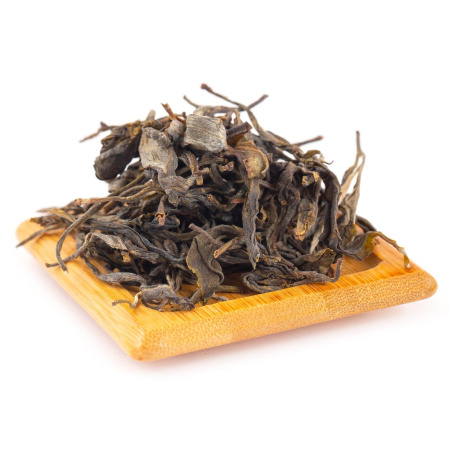Nanben Laozhai Village is located in the west of Mengsong Township, 3 km away from Sanmai Village Committee, and is a mountainous area with an average altitude of 1,693 meters above sea level. In the mountains, there are wild Gu Shu tea trees that are over 500 years old. Pu'er tea collected from such ancient trees has a bright, rich taste and aroma, a strong, long-lasting tea effect, resistance to brewing and a powerful aftertaste.
The aroma of a tea leaf warmed by breath is deep, creeping, sweet. It reminds of stones heated in the sun, forest herbs, baked chestnuts and Nepalese wild honey. The tea is rich in organic surfactants, which foam the infusion like soap when washed. After washing, the aroma is powerful, penetrating, sweet and sour, floral and fruity, complex.
The infusion of ready puer is thick, oily, very soft, fragrant, without bitterness and characteristic astringency. The taste of tea is bright, heady, fruity and floral, with hints of baked mango and buckwheat honey with a touch of herbs. On the 5th infusion, citrus bitterness and herbaceous astringency appear, which quickly give way to the sweetness of flower nectar.
This puer holds steeps very well, just 5 g of dry tea leaves taken in a 150 ml teapot made of Yixing clay brewed 10 times and would hold for several more steeps if the water in the 2-liter thermos had not run out.
The aftertaste is powerful, long-lasting, with a light menthol chill enveloping the tongue and cheeks, with fragrant fruity tones and a gradually emerging honey sweetness.
The intoxicating effect of tea manifests itself after the first cup. Purity, harmony, calm, strong intoxication with sobriety, light pleasant dizziness. Tea Qi is strong, leaves sweat on the forehead, moves in smooth waves throughout the body, adjusting to the current state of the drinker: Puer either strongly tones, increasing efficiency, or gently relaxes, causing a meditative state with breathing calibration.
Gushu Sheng Puer 2020 from Nanben Laozhai village from centuries-old tea trees is a premium high-quality tea with very strong properties and completely ready for tea parties on special occasions. Every year, no more than 3 kg of Mao Cha (tea leaves) are collected from one Gu Shu tree.
|
Name in Chinese
|
南本老寨古树生普洱 |
|
Pinyin
|
nánběn lǎozhài gǔshù shēng pǔ'ěr |
|
Translation
|
Sheng Pu'er from perennial trees in Nanben Laozhai village |
|
Country
|
China |
|
District
|
Pu'er City District |
|
Provinces
|
Yunnan (云南) |
|
Habitat
|
Наньбэнь Лаочжай (南本老寨, Nán běn lǎo zhài) |
|
Raw material production date
|
2020 |
|
Master's name
|
Кы Хэй (黑克, Hēi kè) |
- Комментарии
- Вконтакте
Pu-erh is one of the most unique types of tea, which only gets better with age. Many people, when they first encounter this tea, wondered: why is pu-erh more often found in pressed form (cakes, bricks, tochas), and not in loose form? The reasons for this are related to both history and the practical aspects of storing and fermenting tea. Despite modern technologies that allow the production of loose pu-erh, the shape of pressed cakes remains unchanged. And pu-erh is more often found on sale in pressed form, for example, in the form of cakes or bricks, and loose pu-erh is less common. We will talk about the reasons for pressing pu-erh into cakes in this article.
Puer is a unique Chinese tea that is distinguished by its depth of taste, complexity of aromas and versatility of aftertaste. Its taste characteristics are formed under the influence of many factors, from growing conditions to the brewing method. Let's look at the main ones.



















































































